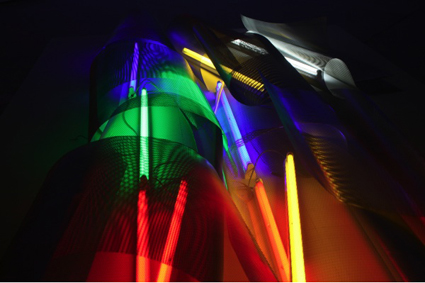light: substantially
danni zuvela: peter kennedy, ima, brisbane

Peter Kennedy: Light Years 1970-1
AUSTRALIAN CONCEPTUAL ART PIONEER PETER KENNEDY’S WORK WAS THE SUBJECT OF A RECENT MAJOR EXHIBITION AT THE INSTITUTE OF MODERN ART, BRISBANE. LIGHT YEARS 1970-1 PRESENTED WORKS FROM THREE SOLO SHOWS OF INSTALLATION, LIGHT, PERFORMANCE AND SOUND WORK THE ARTIST MOUNTED IN 1970 AND 1971. KENNEDY BEGAN TO EXPLORE THE POSSIBILITIES OF MINIMALIST ART WORK WHILST WORKING AS A SIGN DESIGNER AT CLAUDE NEON, CHANNELLING HIS INDUSTRIAL EXPERIENCE INTO A SERIES OF WORKS EXPLORING THE CREATIVE POTENTIAL OF THE MASS-PRODUCED MEDIUM OF NEON TUBES IN THE GALLERY SETTING.
Neon Light Installations (1970/2011) is one of Kennedy’s key early light works and one of the best-known early instances of Australian light art. Kennedy first presented the work in February, 1970, at the Sydney incarnation of the ground-breaking contemporary art space, Gallery A. In the spacious concrete IMA cavern in Brisbane, the straight lengths of coloured neon, intensified by reflective housings, occupied not just the vertical surfaces of the walls, but the corners, ceiling-lines and gleaming horizontal expanse of the floor. What is illuminated is not the material per se, but its effects, drawing our attention to the nature of light as a temporal and spatial presence. Pouring itself around the room’s contours—literally escaping framing conventions—this work treats all interior surfaces as a single, distributed compositional material, one that registers both the interplay of overlapping beams and incidental reflections, and the movement of spectators’ bodies throughout the gallery space: light describing a room.
This contingency is taken further with Luminal Sequences, from Kennedy’s second and final show at Gallery A Sydney, in March 1971, which played on the subjectivity of time through the integration of documentation into subsequent iterations of the artwork. In this work, past and present, the actual and the depicted, absence and presence are brought together in a work featuring neon lights on timers, spotlights and slide projectors. The projections, featuring images of the gallery space, the light work itself and spectators engaging with it, are what shifts the work into a critical postmodernist terrain. This kind of art practice has a long history, as the IMA’s attendant screening of trailblazer László Moholy-Nagy’s Lightplay Black-White-Grey (1930) showed, but with the incorporation of viewers into the ongoing expression of the work and the series of effects this generates, inter alia, about the relations between perceiving bodies, the artwork and documentation, marks the point where high modernist abstraction gives way to conceptualism.
Concurrent with the second Gallery A show in 1971, Kennedy staged another exhibition at Inhibodress, the infamous alternative space he ran with artist Mike Parr (who featured prominently in Let the Healing Begin, the IMA exhibition immediately prior to Kennedy’s). But the Fierce Blackman was a John Cage-inspired sound-performance piece embracing chance operations in subject matter, tones, duration and dynamics. At the heart of this piece was a looped tape recording of Kennedy repeatedly intoning the (randomly chosen) mantra “but the fierce blackman” over a PA, accompanied by a television tuned to static, which intercepted moments of radio signals from passing taxis and a whirring electric fan. In the original performance, the artist appeared at half-hour intervals to intervene with further recitals of the phrase live through the PA. Installed as a documentation piece, while still menacing—owing to the powerful echoes of the artist’s distorted vocals throughout the space—the work appeared to lose some of its ostensive intensity, coming across more as a sound art piece than the exploration of “interference variables” the artist described. Restaging it as a live performance work, rather than reproducing it as an installation, might have accessed more of the work’s heated multiplicity.
In other works, the restaging took advantage of later developments of the works, such as the nesting of the neon tubes of Neon Light Installations in tangles of soft wood wool, which invited a dialectic between rigid containment and diffuse modulation, between synthetic and organic, gas and glass and between the optical and haptical address of the work. At their best, Kennedy’s works produce effects that are powerfully distinct from their material forms; it’s not only electrons being excited to a higher quantum state, but an entire spectrum of visible and invisible forces that are harnessed as his subject.
Peter Kennedy: Light Years 1970-1, Institute of Modern Art, Brisbane, May 7-June 25; Artificial Light Films, Institute of Modern Art, Brisbane. A joint project with OtherFilm, May 26; Let the Healing Begin, Institute of Modern Art, Brisbane, March 5-April 30
RealTime issue #104 Aug-Sept 2011 pg. 55






